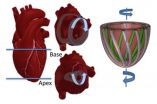(Press-News.org) Early humans may have evolved black skin to protect against a very high risk of dying from ultraviolet light (UV)-induced skin cancer, a new analysis concludes.
Skin cancer has usually been rejected as the most likely selective pressure for the development of black skin because of a belief that it is only rarely fatal at ages young enough to affect reproduction.
But a new paper, published in Proceedings of the Royal Society B, cites evidence that black people with albinism from parts of Africa with the highest UV radiation exposure, and where humans first evolved, almost all die of skin cancer at a young age.
The paper, by Professor Mel Greaves at The Institute of Cancer Research, London, cites studies showing that 80 per cent or more of people with albinism from African equatorial countries such as Tanzania and Nigeria develop lethal skin cancers before the age of 30.
Albinism is also linked to skin cancer in indigenous populations of other tropical countries with high, year-round UV exposure such as Panama.
Professor Greaves argues that the fact that people with albinism, which is caused by genetic changes that prevent the production of melanin, develop cancer at reproductive ages is indirect but persuasive evidence that early, pale-skinned humans were under strong evolutionary pressure to develop melanin-rich skin in order to avoid lethal skin cancer.
Genetic evidence suggests that the evolution of skin rich in eumelanin, which is brown-black in colour, occurred in early humans between 1.2 and 1.8 million years ago in the East African Savannah. Early humans having lost most of their body hair (probably to facilitate heat loss) probably had pale skin containing pheomelanin - like our nearest surviving relatives, chimpanzees. Pheomelanin, characteristic of white skin, is red-yellow and packaged into smaller stores under the skin than eumelanin, characteristic of black skin. Eumelanin provides a much more effective barrier against the DNA damage that causes skin cancers, providing almost complete protection.
Most scientists agree the development of black skin occurred in early humans primarily because of the ability of eumelanin to effectively absorb ultraviolet radiation, but they have debated exactly how this could have protected early humans against lethal diseases.
As well as affecting skin cancer risk, increased black melanin production could have given other benefits that helped individuals to pass on their genes to the next generation, such as preventing damage to sweat glands or the destruction of folate, which is important in foetal development.
While there could have been many benefits of having black skin in Africa (and retaining it in New Guinea), Professor Greaves argues that individuals with albinism and no protective benefit from melanin almost all die young from cancer.
Professor Greaves is Director of the new Centre for Evolution and Cancer at The Institute of Cancer Research (ICR). The Centre aims to gain new insights into how individual cancers evolve – the process behind the development of drug resistance, and the often extraordinary genetic diversity within single tumours – and to uncover clues in our evolutionary history that could help us understand why human cancers develop.
Professor Mel Greaves, Director of the Centre for Evolution and Cancer at The Institute of Cancer Research, London, said:
"Charles Darwin thought variation in skin colour was of no adaptive value and other investigators have dismissed cancer as a selective force in evolution. But the clinical data on people with albinism, particularly in Africa, provide a strong argument that lethal cancers may well have played a major role in early human evolution as an important factor in the development of skin rich in dark pigmentation - in eumelanin."
INFORMATION:
For more information contact the ICR press office on 020 7153 5312 / henry.french@icr.ac.uk. For enquiries out of hours, please call 07976 751984.
Notes to editors
1. As humans migrated out of Africa north into Europe some 50-80,000 years ago, there was substantially less UV exposure and a selective advantage in having paler skin, probably to obtain more vitamin D.
2. The skin cancers basal cell carcinoma (BCC), squamous cell carcinoma (SCC) and malignant melanoma (MM) are collectively the most common cancers of man. There is general agreement that excessive sun exposure is the major cause (acute for MM, chronic and sustained for BCC and SCC). White- or pale-skinned people are most at risk (1,000 times more than black people) and risk is related to modern lifestyle exposures. These conclusions are endorsed by genetic data showing that inherited gene variants associated with risk of skin cancers encode genes involved in melanin pigmentation.
The Institute of Cancer Research, London, is one of the world's most influential cancer research institutes.
Scientists and clinicians at The Institute of Cancer Research (ICR) are working every day to make a real impact on cancer patients' lives. Through its unique partnership with The Royal Marsden Hospital and 'bench-to-bedside' approach, the ICR is able to create and deliver results in a way that other institutions cannot. Together the two organisations are rated in the top four cancer centres globally.
The ICR has an outstanding record of achievement dating back more than 100 years. It provided the first convincing evidence that DNA damage is the basic cause of cancer, laying the foundation for the now universally accepted idea that cancer is a genetic disease. Today it leads the world at isolating cancer-related genes and discovering new targeted drugs for personalised cancer treatment.
As a college of the University of London, the ICR provides postgraduate higher education of international distinction. It has charitable status and relies on support from partner organisations, charities and the general public.
The ICR's mission is to make the discoveries that defeat cancer. For more information visit http://www.icr.ac.uk
Skin cancer risk may have driven evolution of black skin
2014-02-26
ELSE PRESS RELEASES FROM THIS DATE:
Smithsonian scientists solve 'sudden death at sea' mystery
2014-02-26
Mass strandings of whales have puzzled people since Aristotle. Modern-day strandings can be investigated and their causes, often human-related, identified. Events that happened millions of years ago, however, are far harder to analyze—frequently leaving their cause a mystery. A team of Smithsonian and Chilean scientists examined a large fossil site of ancient marine mammal skeletons in the Atacama Desert of Northern Chile—the first definitive example of repeated mass strandings of marine mammals in the fossil record. The site reflected four distinct strandings over time, ...
Brain cell activity regulates Alzheimer's protein
2014-02-26
Increased brain cell activity boosts brain fluid levels of a protein linked to Alzheimer's disease, according to new research from scientists at Washington University School of Medicine in St. Louis.
Tau protein is the main component of neurofibrillary tangles, one of the hallmarks of Alzheimer's disease. It has been linked to other neurodegenerative disorders, including frontotemporal dementia, supranuclear palsy and corticobasal degeneration.
"Healthy brain cells normally release tau into the cerebrospinal fluid and the interstitial fluid that surrounds them, but ...
SMA unveils how small cosmic seeds grow into big stars
2014-02-26
New images from the Smithsonian's Submillimeter Array (SMA) telescope provide the most detailed view yet of stellar nurseries within the Snake nebula. These images offer new insights into how cosmic seeds can grow into massive stars.
Stretching across almost 100 light-years of space, the Snake nebula is located about 11,700 light-years from Earth in the direction of the constellation Ophiuchus. In images from NASA's Spitzer Space Telescope it appears as a sinuous, dark tendril against the starry background. It was targeted because it shows the potential to form many massive ...
Follow-up care for older breast cancer survivors needs to be all-encompassing
2014-02-26
Older women who have overcome breast cancer are likely to struggle with heart disease, osteoporosis and hypertension further on in their lives. Whether these conditions occur or not is influenced by the treatment that patients received to fight cancer, their overall weight and their age. Breast cancer survivors therefore should watch their weight and get regular exercise so that they can enjoy a high quality of life. These findings, by lead author Nadia Obi of the University Medical Center Hamburg-Eppendorf, who collaborated with the group of Prof. Chang-Claude from the ...
New research indicates causal link between vitamin D, serotonin synthesis and autism
2014-02-26
February 26, 2014 - Oakland, CA – A new study by Rhonda Patrick, PhD and Bruce Ames, PhD of Children's Hospital Oakland Research Institute (CHORI) demonstrates the impact that Vitamin D may have on social behavior associated with Autism Spectrum Disorder (ASD). Dr. Patrick and Dr. Ames show that serotonin, oxytocin, and vasopressin, three brain hormones that affect social behavior, are all activated by vitamin D hormone. Autism, which is characterized by abnormal social behavior, has previously been linked to low levels of serotonin in the brain and to low vitamin D levels, ...
Beaumont study: Gamma Knife helps patients with painful facial nerve disorder
2014-02-26
Research by Beaumont Health System radiation oncologists and neurosurgeons found that symptoms of trigeminal neuralgia, or TN, a nerve disorder causing severe facial pain, were reduced in those treated with Gamma Knife stereotactic radiosurgery. The results were published in the February issue of the journal Clinical Neurology and Neurosurgery.
TN is a disorder of the trigeminal nerve, which is responsible for feeling in the face. In most cases, the facial pain is caused by a blood vessel pressing on the nerve. It is believed that TN is caused by deterioration of the ...
Reproductive coercion, intimate partner violence prevalent
2014-02-26
Enough women experience reproductive coercion – male behavior to control contraception and pregnancy outcomes – that a research team now recommends health care providers address the subjects with their patients and tailor family planning discussions and recommendations accordingly.
Researchers from Women & Infants Hospital of Rhode Island were part of a team that published "Reproductive coercion and co-occurring intimate partner violence in obstetrics and gynecology patients" in a recent issue of the American Journal of Obstetrics and Gynecology.
"Reproductive coercion, ...
Artificial muscles that do the twist
2014-02-26
In the heart, as in the movies, 3D action beats the 2D experience hands down.
In 3D, healthy hearts do their own version of the twist. Rather than a simple pumping action, they circulate blood as if they were wringing a towel. The bottom of the heart twists as it contracts in a counterclockwise direction while the top twists clockwise. Scientists call this the left ventricular twist—and it can be used as an indicator of heart health.
The heart is not alone. The human body is replete with examples of soft muscular systems that bend, twist, extend, and flex in complex ...
Superabsorbing design may lower manufacturing cost of thin film solar cells
2014-02-26
Researchers from North Carolina State University have developed a "superabsorbing" design that may significantly improve the light absorption efficiency of thin film solar cells and drive down manufacturing costs.
The superabsorbing design could decrease the thickness of the semiconductor materials used in thin film solar cells by more than one order of magnitude without compromising the capability of solar light absorption.
"State-of-the-art thin film solar cells require an amorphous silicon layer that is about 100 nanometers (nm) thick to capture the majority of the ...
A cavity that you want
2014-02-26
BUFFALO, N.Y. – Associated with unhappy visits to the dentist, "cavity" means something else in the branch of physics known as optics.
Put simply, an optical cavity is an arrangement of mirrors that allows beams of light to circulate in closed paths. These cavities help us build things like lasers and optical fibers used for communications.
Now, an international research team pushed the concept further by developing an optical "nanocavity" that boosts the amount of light that ultrathin semiconductors absorb. The advancement could lead to, among other things, more powerful ...





